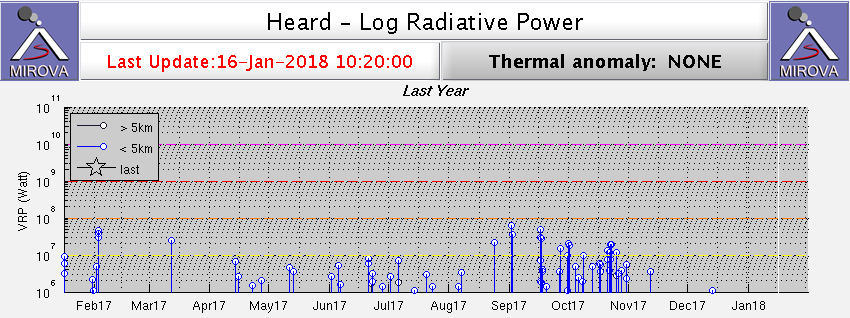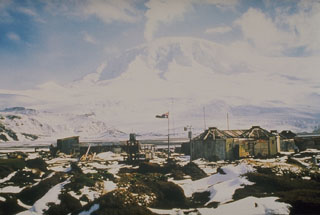Report on Heard (Australia) — January 2018
Bulletin of the Global Volcanism Network, vol. 43, no. 1 (January 2018)
Managing Editor: Edward Venzke.
Research and preparation by Jackie Gluck.
Heard (Australia) Intermittent low-to-moderate thermal anomalies end in mid-November 2017
Please cite this report as:
Global Volcanism Program, 2018. Report on Heard (Australia) (Venzke, E., ed.). Bulletin of the Global Volcanism Network, 43:1. Smithsonian Institution. https://doi.org/10.5479/si.GVP.BGVN201801-234010
Heard
Australia
53.106°S, 73.513°E; summit elev. 2745 m
All times are local (unless otherwise noted)
The most recent eruptive period at Heard began in September 2012 (BGVN 38:01). Direct observations are rare at this remote volcano, but the presence of lava flows can frequently be discerned using infrared satellite data. Thermal anomalies were intermittent, with some episodes of clearly stronger activity, during 2016 and through September 2017 (BGVN 42:10).
During all of 2017, MODIS infrared satellite data analyzed using the MODVOLC algorithm showed anomalies near the summit only on 2, 16, and 26 September, and on 1 and 22 October. The MIROVA system also detected numerous hotspots within 5 km of the volcano through late October. One additional significant anomaly was identified on approximately 12 November 2017 (figure 31). No further significant anomalies were noted through February 2018.
 |
Figure 31. Low to moderate power thermal anomalies in MODIS data were identified by the MIROVA system in September and October, with another on approximately 12 November 2017. Courtesy of MIROVA. |
Geological Summary. Heard Island on the Kerguelen Plateau in the southern Indian Ocean consists primarily of the emergent portion of two volcanic structures. The large glacier-covered composite basaltic-to-trachytic cone of Big Ben comprises most of the island, and the smaller Mt. Dixon lies at the NW tip of the island across a narrow isthmus. Little is known about the structure of Big Ben because of its extensive ice cover. The active Mawson Peak forms the island's high point and lies within a 5-6 km wide caldera breached to the SW side of Big Ben. Small satellitic scoria cones are mostly located on the northern coast. Several subglacial eruptions have been reported at this isolated volcano, but observations are infrequent and additional activity may have occurred.
Information Contacts: MIROVA (Middle InfraRed Observation of Volcanic Activity), a collaborative project between the Universities of Turin and Florence (Italy) supported by the Centre for Volcanic Risk of the Italian Civil Protection Department (URL: http://www.mirovaweb.it/); Hawai'i Institute of Geophysics and Planetology (HIGP) - MODVOLC Thermal Alerts System, School of Ocean and Earth Science and Technology (SOEST), Univ. of Hawai'i, 2525 Correa Road, Honolulu, HI 96822, USA (URL: http://modis.higp.hawaii.edu/).

